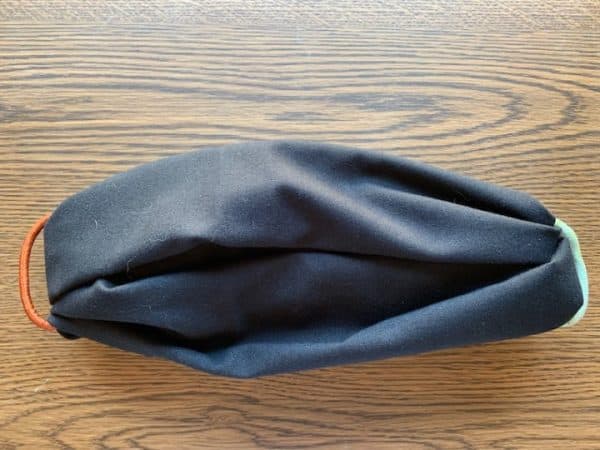The Centers for Disease Control and Prevention has advised wearing cloth face coverings when you go out in public, to help slow the spread of COVID-19. With face masks hard to find, we suggest you just make your own. If you sew, there are many patterns out there. But we found a pattern so simple, provided by the CDC, that no sewing is required.
The cloth face masks are to be used in addition to the other very important measures that you should already be practicing:
- Only go in public for essential activities, like buying food or medications, and as infrequently as possible. Here’s information about how to get groceries delivered and more places to buy food online.
- When in public, stay six feet from other people.
- Wash your hands frequently.
- Don’t touch your face.
There are many DIY instructions for making your own face covering from items you have around the house, but the CDC provides a video that is all you really need to see, if you don’t sew.
https://www.youtube.com/watch?v=tPx1yqvJgf4
This method requires nothing but a bandana (or a piece of cloth around 22×22 inches) and two rubber bands. Note that the rubber bands will go around your ears, which isn’t too comfortable for extended periods of time, so this can be further motivation to keep your time in public to an absolute minimum. Alternatives to rubber bands are hair ties and clean shoelaces.
Make sure to use tightly woven fabric. Don’t use quilted or perforated fabric. Hold it up to the light. The less light that gets through, the better.
It’s not in the video, but on the tutorial page, the CDC recommends tucking a coffee filter in the material, to offer additional filtering.
The CDC also offers instructions on sewing face masks, or making a no-sew one from an old t-shirt, on that same tutorial page.
A few other simple ways to make face masks:
- If you have any eye masks like the ones you wear on airplanes (or if you’ve ever flown business class and saved the kit they give you they usually include). You can take the mask and turn it upside down and it fits over your nose and covers your mouth.
- If you have a fabric sleeve that holds an ice pack, you can use that material as a washable face mask. It’s even better if it has a Velcro strap because you can just cover your face and run the Velcro strap behind your head and adjust to fit.
Important notes about wearing a face mask
Don’t get complacent. As time goes on, don’t allow yourself to relax your other safety measures, including staying at home, maintaining a six-foot distance from other people, washing your hands frequently, and avoiding touching your face.
Remove it safely. When you get home, remove it from the ear loops, not the cloth part.
Wash it frequently. We will be washing ours after every use. Since we’re hardly ever going out in public, this is not that frequent. We’ll be washing it in the washing machine, with hot water. If we use the no-sew kind (like in the above video), we’ll remove the rubber bands before washing.
Wash your hands. After taking it off and throwing it in the washing machine, wash your hands thoroughly.
Buying face masks
Buying handmade face masks
There are tons of people selling hand-made face masks on Etsy. You can expect longer wait times as the demand has risen dramatically for these items. If you do purchase one from Etsy, make sure to look at the delivery time, as it could be weeks (or more) out. Look for sellers in the United States.
Also, try to find one that has a pocket to put a filter in. The CDC has suggested using coffee filters. We’ve seen other recommendations for using vacuum bag filters.
Buying face masks on Amazon
You can also find face masks on Amazon. As with the hand made masks on Etsy, you might find arrival times pretty far out. Hopefully, manufacturing (whether industrial or hand-made) will increase, in the short term, to somewhat keep up with the demand. So make yourself one of those no-sew face coverings while you wait.
Don’t buy N95 masks for yourself
Please don’t buy N95 masks or surgical masks for your own trip to the grocery store. Our hospitals desperately need them, and they are in short supply.
If you sew and want to help
Nationwide, people are sewing face masks to help out health-care workers. Fabric masks usually aren’t enough for hospital workers, but they can be helpful to workers in nursing homes, veterinary clinics, senior facilities and or non-medical personnel at hospitals. Check in your community to see where your contribution can be best used.
JoAnn fabric stores is providing precut fabric, facilities and pickup service at selected stores for people who want to make and donate masks. The store also has tutorials and video instructions online.
Good Housekeeping has a tutorial and a video for making fabric face masks.
Jody Mace of Charlotte on the Cheap, Laura Daily of Mile High on the Cheap and Teresa Mears of Miami on the Cheap contributed to this report.
More Useful Resources
- Free online yoga classes to do at home
- How to mail packages from home
- Decluttering? Sell on Facebook to earn quick cash!
- Legitimate work-at-home-jobs you can do now
- 5 free apps to help improve your fitness
- Podcasts offer education, entertainment for the whole family
- Pet behavior help lines offer free tips and advice
- 30% off Eat at Home meal plan service before Aug. 31
- How to order groceries online: comparing services
- Cute animal webcams you can’t stop watching

